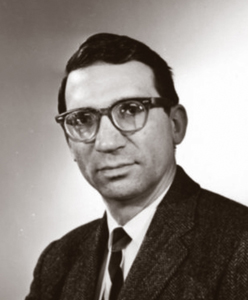
I was sorry to learn today of the passing of Ted Buttrey of the Fitzwilliam Museum in Cambridge. I had just corresponded with him a few months ago. He was a gracious host some
ten years ago when I was living in London and came out to visit him and the magnificent coin collection at the Fitzwilliam.
Buttrey of course is known in the U.S. for calling out false Western American gold bars and battling with the legendary John J. Ford, Jr. Thanks to David Fanning for word of Ted's death and
Philip Mernick for pointing me to Buttrey's Wikipedia page, from which I've excerped the following information. The photo is from Buttrey's page at the University of Michigan.
-Editor
 Theodore Vern Buttrey Jr. (born Havre, Montana December 29, 1929, died Cambridge, UK January 9, 2018) was an American educator, classicist and numismatist. He is perhaps best known for his
work discovering and exposing a scheme to distribute fake Western American gold bars. Theodore Vern Buttrey Jr. (born Havre, Montana December 29, 1929, died Cambridge, UK January 9, 2018) was an American educator, classicist and numismatist. He is perhaps best known for his
work discovering and exposing a scheme to distribute fake Western American gold bars.
Personal
Buttrey was born in Havre, Montana on December 29, 1929, the son of Theodore V. Buttrey Sr. and Ruth Jeanette (Scoutt) Buttrey and the grandson of Frank A. Buttrey, the founder of Buttrey Food and
Drug. He was educated at Peacock Military Academy, graduated from the Phillips Exeter Academy in 1946, and graduated magna cum laude with a degree in Classics from Princeton University in 1950. He
was awarded his Ph.D. from Princeton in 1953, and after obtaining a Fulbright Scholarship for further study in Rome, began his academic career at Yale University in 1954. Buttrey's first marriage
produced four children and ended in divorce; a second marriage produced no children and ended likewise. Buttrey was survived by his third wife, whom he married in October of 2017.
Career as Professor
In 1964, Buttrey took a position in the Classics Department at the University of Michigan. He was promoted to (full) Professor in 1967, and served as Chair of the Department for several years. From
1969 to 1971 he was also the Director of the Kelsey Museum of Archaeology at the University of Michigan. He is remembered as part of the University's Faculty History Project which includes a
statement from the University's Regents.
Buttrey had been a Visiting Fellow and Resident Member of Clare Hall, Cambridge University. After retiring from Michigan he moved to Cambridge where he was an Affiliated Lecturer in the Faculty of
Classics. He served as Keeper of Coins and Medals at the Fitzwilliam Museum from 1988 to 1991 and from 2008 until his death held the post of Honorary Keeper of Ancient Coins.
Numismatic Work
Coins of Ancient Greece and Rome
Buttrey spent many years active in research on coins of the ancient Mediterranean. He and his collaborators documented the coinage of Sardis, in modern-day Turkey (and formerly under the control of
the Persian and Roman Empires), and, as part of a long-term Princeton University project, he also investigated the coinage at Morgantina, in modern-day Sicily. He was involved in the publication of
the numismatic finds from numerous excavations in Britain, Italy (Cosa, Rome Palatine, Rome Forum), Libya (Apollonia, Cyrene, Euesperides), and Israel.
Coins of Mexico
It was as a child at the Peacock Military Academy in San Antonio, Texas that Buttrey first encountered, and became interested in, the coins of Mexico. Although as an adult his primary professional
pursuits as a scholar were elsewhere, he continued his interest in Mexican coins into adulthood as well. His "Guidebook of Mexican Coins, 1822 to Date" (1969), together with subsequent
editions (up to the 6th Edition in 1992, this one with first author Clyde Hubbard) is considered the seminal work on the subject.
Fake Mexican and Western American Gold Bars
Although the bulk of Buttrey's academic output concerned coins of antiquity, Buttrey was directly involved in a controversy regarding Western American gold bars that he described as counterfeit.
This followed earlier, apparently uncontroversial, work in which he was able to identify certain Mexican gold bars as counterfeit, primarily by cataloguing anachronistic assayer markings. That
earlier work was capped by Buttrey's 1973 talk, "False Mexican Colonial Gold Bars" at the International Numismatic Congress. In 1984, the American Numismatic Society passed a resolution
supporting Buttrey's assertions.
The dispute regarding the Western American bars was quite possibly the only time a dispute among academic numismatists reached the pages of major newspapers, including the New York Times.
Buttrey's claims about the authenticity of the western bars were first detailed in a 1996 talk at the ANS. They were based in part on mint and assay markings that he said were incongruous or
inconsistent. He also noted that many of the bars in question had no provenance at all, never appearing in catalogues or other materials from the time that the bars were allegedly produced through
the 1950s.
To read the complete Wikipedia article, see:
Theodore V. Buttrey Jr. (https://en.wikipedia.org/wiki/Theodore_V._Buttrey_Jr.)
To read the Michigan Faculty History page, see:
Theodore V. Buttrey (https://www.lib.umich.edu/faculty-history/faculty/theodore-v-buttrey)

Wayne Homren, Editor
The Numismatic Bibliomania Society is a non-profit organization
promoting numismatic literature. See our web site at coinbooks.org.
To submit items for publication in The E-Sylum, write to the Editor
at this address: whomren@gmail.com
To subscribe go to: https://my.binhost.com/lists/listinfo/esylum
Copyright © 1998 - 2024 The Numismatic Bibliomania Society (NBS)
All Rights Reserved.
NBS Home Page
Contact the NBS webmaster
|



